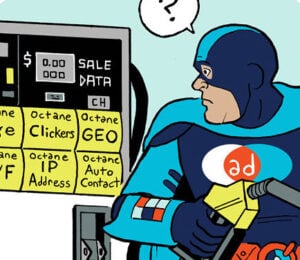Too bad actor Ryan Reynolds didn’t join CTV ad platform MNTN’s first-ever earnings call on Tuesday.
It would’ve been fun hearing Deadpool answer questions from investors.
In early April, not long after MNTN filed its S-1 and shortly before its IPO in May, the company divested Maximum Effort. That’s the creative agency co-founded by Reynolds that MNTN had acquired in 2021.
Reynolds remains MNTN’s chief creative officer and its No. 1 celebrity shill. And Maximum Effort is still going strong.
Anyway, the purpose of that divestiture was to help MNTN simplify its financial structure ahead of its IPO and focus more on its core business – a strategy that appears to have worked.
MNTN’s Q2 revenue grew 25% year over year to $68.5 million without Max Effort and would have grown 34% with the agency still on its balance sheet.
What’s interesting, though, is that without the creative agency on board, MNTN’s gross margin improved significantly in Q2, up 7% to 77%. In other words, MNTN is more profitable now.
The market, however, wasn’t overly impressed. The company’s stock dipped by just over 3% in after-hours trading. Welcome to Wall Street.
MNTN + SMBs
There are a few other reasons why MNTN’s margins are improving, according to CEO and President Mark Douglas, one of the main ones being that the platform is attracting more small and medium-size businesses.
The vast majority of MNTN’s customers (97%) are SMBs that are advertising on TV for the first time, meaning that “97 cents of every dollar spent on MNTN is net new revenue into this industry,” Douglas said.
SMBs mostly use MNTN’s self-serve platform, so the company can keep its sales team lean. “We haven’t added headcount in sales in over three years,” Douglas said. And 77% of its revenue now comes from inbound leads, which means marketing costs can stay low.
MNTN is also investing in AI technologies to lower the cost of creating TV commercials and applying AI to its sales process to make it more efficient, Douglas said.
For example – and this is kinda wild – one of MNTN’s sales strategies is to use its own AI-powered targeting tech to upsell customers and reach prospects.
For its advertiser clients, MNTN matches email addresses to households by analyzing data, like shopping habits, interests and behavior, and then links the emails to specific homes and CTV devices based on its predictions of which customers are most likely to engage.
For itself, MNTN pretty much does the same thing, said COO Chris Innes.
“Our go-to-market is that we take the email addresses of our future customers, we upload them to our platform, which matches to their household, and we start serving TV commercials directly to their living room,” Innes said. “If we want to expand into a new vertical or a new part of the market, we just need those email addresses.”
MNTN’s margins
Going forward, MNTN plans to keep on being scrappy like that.
When MNTN first started – back when it used to be called SteelHouse and it was countersuing Criteo over allegations that it used click fraud to inflate performance metrics – roughly one-third of the company was made up of engineers.
Today, more than 40% of the headcount are engineers, and that’s on its way to hitting more than 50%.
“One out of every two people working at MNTN will be in engineering,” Douglas said, “and every new hire is a strategic hire.”
MNTN is now aiming for a long-term gross margin in the 75% to 80% range, with ongoing plans to reduce hosting and media costs in the coming quarters and focus on tech development.
“We’re going to spend additional money on engineers to improve and maintain the product and develop new products,” said CFO Patrick Pohlen. “We’re sitting in that range already.”












